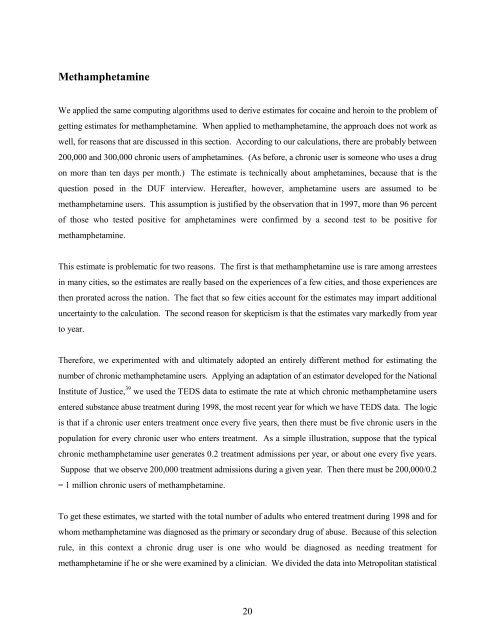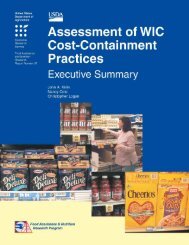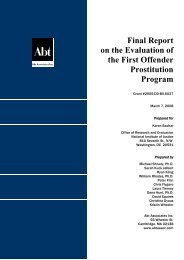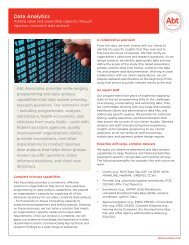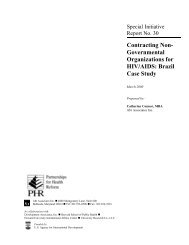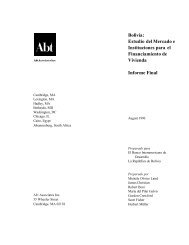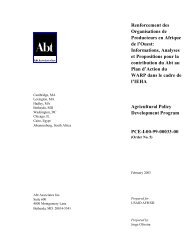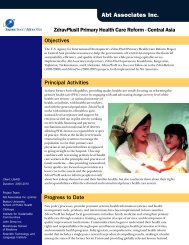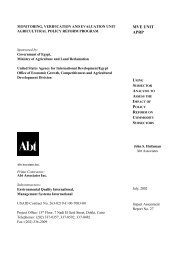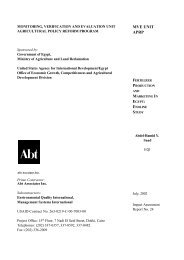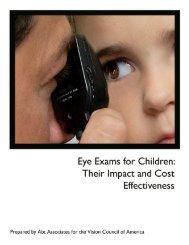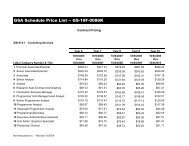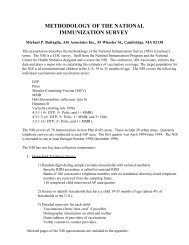What America's Users Spend on Illegal Drugs 1988-2000 - National ...
What America's Users Spend on Illegal Drugs 1988-2000 - National ...
What America's Users Spend on Illegal Drugs 1988-2000 - National ...
- No tags were found...
Create successful ePaper yourself
Turn your PDF publications into a flip-book with our unique Google optimized e-Paper software.
MethamphetamineWe applied the same computing algorithms used to derive estimates for cocaine and heroin to the problem ofgetting estimates for methamphetamine. When applied to methamphetamine, the approach does not work aswell, for reas<strong>on</strong>s that are discussed in this secti<strong>on</strong>. According to our calculati<strong>on</strong>s, there are probably between200,000 and 300,000 chr<strong>on</strong>ic users of amphetamines. (As before, a chr<strong>on</strong>ic user is some<strong>on</strong>e who uses a drug<strong>on</strong> more than ten days per m<strong>on</strong>th.) The estimate is technically about amphetamines, because that is thequesti<strong>on</strong> posed in the DUF interview. Hereafter, however, amphetamine users are assumed to bemethamphetamine users. This assumpti<strong>on</strong> is justified by the observati<strong>on</strong> that in 1997, more than 96 percentof those who tested positive for amphetamines were c<strong>on</strong>firmed by a sec<strong>on</strong>d test to be positive formethamphetamine.This estimate is problematic for two reas<strong>on</strong>s. The first is that methamphetamine use is rare am<strong>on</strong>g arresteesin many cities, so the estimates are really based <strong>on</strong> the experiences of a few cities, and those experiences arethen prorated across the nati<strong>on</strong>. The fact that so few cities account for the estimates may impart additi<strong>on</strong>aluncertainty to the calculati<strong>on</strong>. The sec<strong>on</strong>d reas<strong>on</strong> for skepticism is that the estimates vary markedly from yearto year.Therefore, we experimented with and ultimately adopted an entirely different method for estimating thenumber of chr<strong>on</strong>ic methamphetamine users. Applying an adaptati<strong>on</strong> of an estimator developed for the Nati<strong>on</strong>alInstitute of Justice, 39 we used the TEDS data to estimate the rate at which chr<strong>on</strong>ic methamphetamine usersentered substance abuse treatment during 1998, the most recent year for which we have TEDS data. The logicis that if a chr<strong>on</strong>ic user enters treatment <strong>on</strong>ce every five years, then there must be five chr<strong>on</strong>ic users in thepopulati<strong>on</strong> for every chr<strong>on</strong>ic user who enters treatment. As a simple illustrati<strong>on</strong>, suppose that the typicalchr<strong>on</strong>ic methamphetamine user generates 0.2 treatment admissi<strong>on</strong>s per year, or about <strong>on</strong>e every five years.Suppose that we observe 200,000 treatment admissi<strong>on</strong>s during a given year. Then there must be 200,000/0.2= 1 milli<strong>on</strong> chr<strong>on</strong>ic users of methamphetamine.To get these estimates, we started with the total number of adults who entered treatment during 1998 and forwhom methamphetamine was diagnosed as the primary or sec<strong>on</strong>dary drug of abuse. Because of this selecti<strong>on</strong>rule, in this c<strong>on</strong>text a chr<strong>on</strong>ic drug user is <strong>on</strong>e who would be diagnosed as needing treatment formethamphetamine if he or she were examined by a clinician. We divided the data into Metropolitan statistical20


